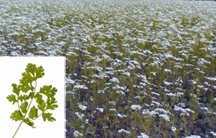Coriander
Coriander (dhoney) a strong-smelling annual herb, Coriandrum sativum, of the family Umbelliferae. Coriander is a native of the Mediterranean region, where it has been growing since ancient times. It is extensively cultivated as a winter crop in Bangladesh.

The plant may grow 30-70 cm high; its lower leaves are broad with cernately-lobed margins, while its upper leaves are finely cut with linear lobes. The flowers of coriander plants are small, white or pink in compound terminal umbels; its fruits are globular, yellow-brown, ribbed, about 3 mm in diameter, and 2-seeded. In Bangladesh the crop is sown is October-November with a seed rate of 10-20 kg/ha and matures in 90-105 days, yielding 1,000-2,000 kg of dried fruits per hectare.
The dried seeds are an important ingredient of curry powder and are also used in pickling spices, sausages, seasonings, confectionery and for flavouring spirits, particularly gin. Young plants are used in chutney, sauces, curries, and soups. The fruits contain a volatile oil, which is used for flavouring, and in medicines.
Coriander relieves flatulence, increases secretion and discharge of urine, and reduces fever. Regular drinking of coriander water helps lower blood cholesterol. A teaspoon of coriander juice, mixed with a pinch of turmeric powder, is an effective remedy for pimples, blackheads, and dry skin. [Nishit Kumar Paul]
See also herbal medicine.
